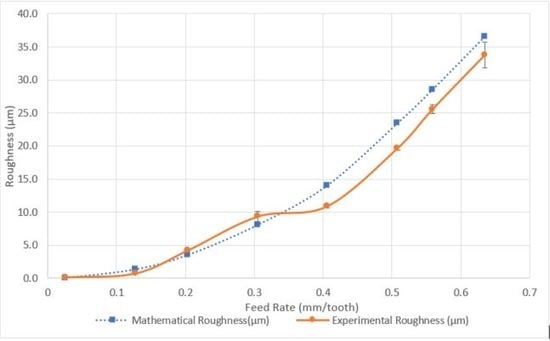In manufacturing industries, milling processes have been widely utilized to remove material from workpieces, producing various sizes, shapes, and features. Face milling is one of the most common milling processes, due to its high efficiency and excellent productivity. In face milling, the cutter is mounted on a spindle, which rotates perpendicular to the machined surface of the workpiece, and material is removed along the path parallel to the machined surface. In the milling process, surface roughness is considered to be one of the most important quality aspects to determine if machine parts will function properly and can be assembled smoothly [
1,
2]. In the measurement of surface roughness, arithmetic average roughness,
Ra, is the most common parameter to describe the topography of a machined surface on a workpiece.
Ra is defined as the arithmetic mean of the deviation of the surface profile from the mean line. Poor workpiece surface quality may cause high wear and friction which can significantly reduce the performance and service duration of sliding components [
3,
4,
5,
6,
7]. Wong et al. [
8] and Tung [
9] both suggested the fuel consumption and performance of automotive engines were mostly controlled by the wear, friction, and lubrication issues between the components in the subsystems which were strongly associated with the machined surfaces. Siripuram et al. [
10] thoroughly studied the effects of asperity geometry on the contact surfaces including the circular square, diamond, hexagonal, and triangular sections. They concluded that thecoefficient of friction between the sliding surfaces was insensitive to the asperity geometry, but quite sensitive to the cross-sectional size. Jocsak et al. [
11] developed a rough surface flow simulation program to model the effects of three-dimensional cylinder liner surface anisotropy on piston ring-pack performance. They found the ring-pack friction could be reduced by decreasing the liner honing cross-hatch angle, which could be achieved using low feed-to-speed ratio in the honing process. Jocsak et al. [
12] also focused on the effects of non-Gaussian surface roughness on piston ring-pack friction in reciprocating natural gas engines.
Most of the models used to predict the surface roughness of a machined surface in milling processes are regression analysis models and neural network models based on empirical formulas derived from a large number of experiments. Kalidass et al. [
13] developed a mathematical model for surface roughness prediction in terms of several cutting parameters, such as rotational speed, feed rate, and depth of cut using a response surface methodology. Tseng et al. [
14] developed an equation to predict surface profile of machined parts in Computerized Numerical Control (CNC) milling by determining the significant factors from experiments and fuzzy set theory.
Franco et al. [
15] derived a numerical model to predict the surface roughness by studying round insert cutting tools and the influence of tool errors, such as radial and axial runouts. Gu et al. [
16] proposed a mathematical model of surface roughness in face milling based on a surface profile produced by a perfectly round insert. Their research was applicable to face milling using a feed rate below a critical value. Felho et al. [
17] developed software to predict the theoretical surface roughness produced by milling inserts of different geometries in arbitrary directions and for any surface size. However, no specific details were given for the theoretical development correlating with the various tool geometries. Munoz-Escalona et al. [
18] produced a surface model based on geometrical analysis of the tool on the machined surface.
Most of the previous models were derived by either assuming perfectly round machine marks for all feed rates, or using statistical analysis based on a large number of experiments. In this research, a model based on the surface profile of the workpiece produced by face milling was developed to predict the mean roughness for three different cases based on the magnitude of feed rate. The approach for modeling is the same as one the used by Gu et al. [
16]. However, additional analysis has been carried out in the present research to allow for prediction of mean roughness at feed rates above those considered in the previous research. In addition, surface roughness values of workpieces in face milling produced using various feed rates were measured using a 3D surface profilometer to determine the correlation between the mathematical model and experimental results.

















